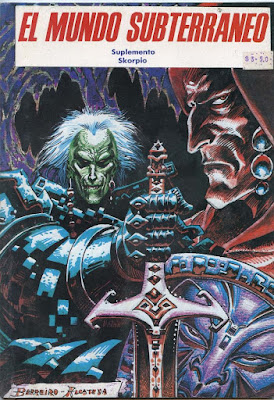The Life and Art of Lee Brown Coye
by Luis Ortiz
Nonstop Press, 2005
'Arts Unknown' (176 pp) is one of a number of overviews of fantasy / sci-fi art edited by Luis Ortiz and published by the Greenwood, Delaware publisher Nonstop Press.
Like many devotees of sci-fi and fantasy literature and art, I was aware to some extent of Lee Brown Coye (1907 - 1981), mainly though his distinctive artwork for the classic Weird Tales pulp magazine, his cover art for Arkham House hardbound books, and, in the late 70s and early 80s, his collaboration with Whispers magazine writer Karl Edward Wagner and editor Stuart David Schiff.
'Arts Unknown' provides an in-depth overview of the artist, his works, and his times.
Coye was born in the small town of Tully and spent most of his life in upstate New York, in locales such as Syracuse, Cazenovia, and Hamilton; anyone who lived or lives in that area will find many informative anecdotes in 'Arts Unknown' about the region in the days when it was prosperous and thriving (as opposed to nowadays being a depressing landscape emblematic of the Rust Belt).
'Arts Unknown' chronicles Coye's life and art in chronological order, assessing his work within the trends and fashions of the art world during the pre- and post- WWII eras. As a self-taught artist, without a network of contacts and patrons, Coye nonetheless was able to gain a degree of appreciation in his homeland of Central New York and, as his career progressed, a measure of notice among the established art community of New York City.
One thing that emerges from 'Arts Unknown' is that Coye was something of an erratic personality, which, when combined with a poor business sense, regularly left him in a state of financial insecurity.
Also revealed in the pages of 'Arts Unknown' is the breadth of Coye's artistic skills, which included the assembly of meticulously crafted dioramas; metalsmithing; and medical illustration.
Although much of the pieces Coye created have been lost over the years, author Ortiz does a commendable job in compiling as much material as could be found. Readers hoping to see Coye's works for Weird Tales and Arkham House will find examples here.
Ortiz does relate some interesting anecdotes behind Coye's famous illustrative motif of crossed sticks, and how this motif came to the attention of Karl Edward Wagner and Stuart Schiff, and the memorable short story 'Sticks' by the former that appeared in Whispers magazine in the March, 1974 issue.
If you're not familiar with this phenomenon of late 70's horror fiction, and its referencing in the 1999 'found footage' film The Blair Witch Project, then this blog has some details (but beware - it also has Spoilers). Another, more lengthy, examination of 'Sticks', Wagner, and Coye is available here.
Summing up, 'Arts Unknown: The Life and Art of Lee Brown Coye' will be of interest to fans of horror and fantasy literature; graphic art; American art of the early 20th century; and even those with an interest in the history and culture of the arts scene in upstate New York in that same time interval. Copies, priced at about $40, can be had from your usual online vendors.






























































.jpg)





















